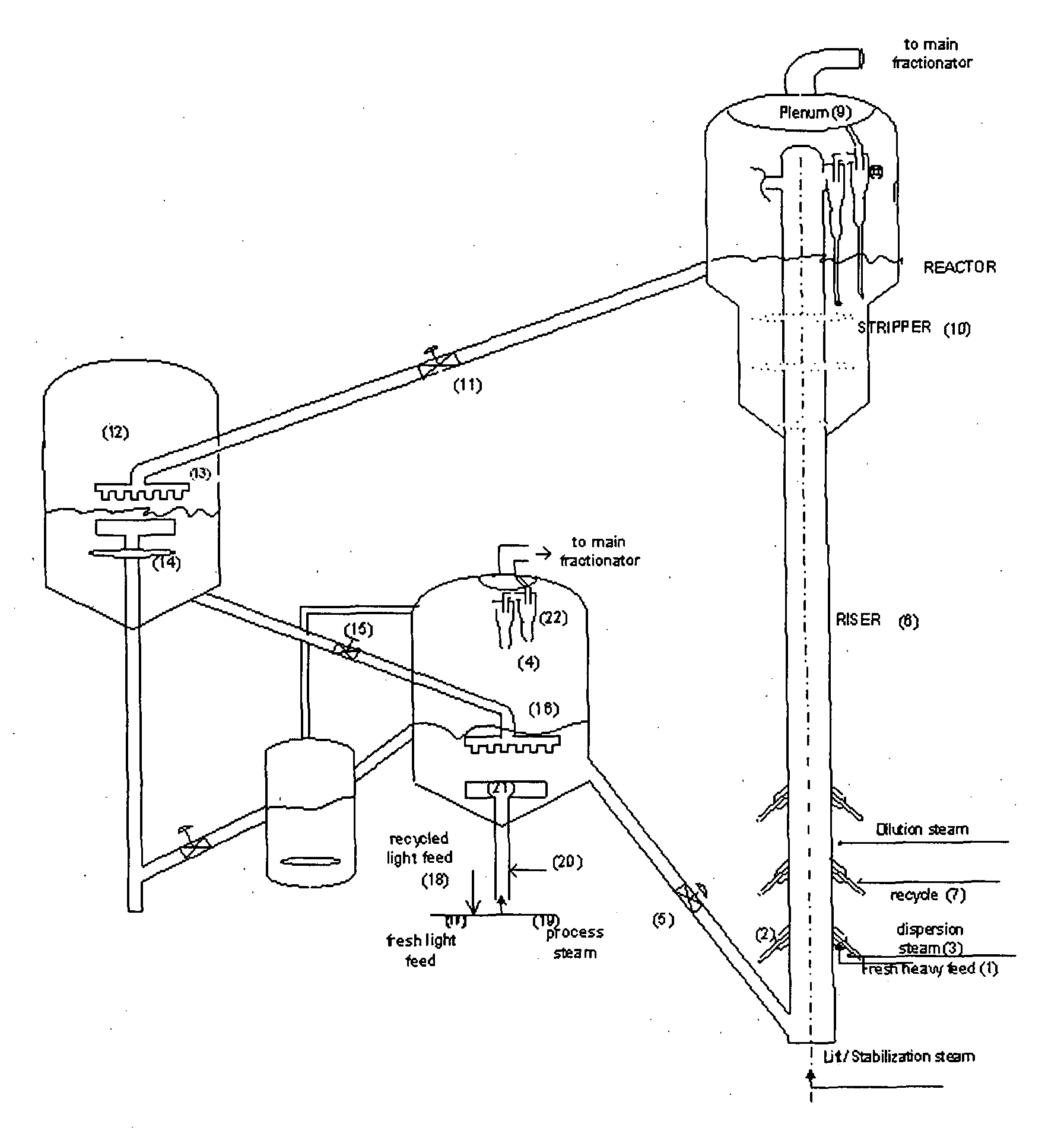Process for simultaneous cracking of lighter and heavier hydrocarbon feed and system for the same
a technology of hydrocarbon feed and simultaneous cracking, which is applied in the direction of hydrocarbon oil treatment, catalytic cracking, furnace types, etc., can solve the problems of increasing the concentration of heavy ends in fcc unit feed with several deleterious effects, reducing conversion, and significant gap between demand and supply of propylene, so as to reduce the sulfur content of cracked products. the effect of boiling
- Summary
- Abstract
- Description
- Claims
- Application Information
AI Technical Summary
Benefits of technology
Problems solved by technology
Method used
Image
Examples
example-1
Yield of Light Olefins at Different Conversions in Conventional FCC Operation
[0083]This example illustrates the change in yield of the light olefins at different conversion levels under conventional FCC conditions. 216° C. conversion is defined as the total quantity of products boiling below 216° C. including coke. The experiments were conducted in standard fixed bed Micro Activity Test (MAT) reactor described as per ASTM D-3907 with minor modifications indicated subsequently as modified MAT. The catalyst is steamed at 810° C. for 3 hours in presence of 100% steam prior to conducting the experiments. The properties of Feed-A used in the modified MAT reactor are given in the Table-1.
TABLE 1Properties of Feed-AUnitFeed-APropertyDensity @ 15° C.gm / cc0.9116Sulfurwt %1.37CCRwt %0.17Basic Nitrogenppmw489Saturates (Paraffin + naphthene)wt %62.6Aromaticswt %37.4Distillation, ASTM D-1160 5 vol %° C.39510 vol %° C.41030 vol %° C.44550 vol %° C.47070 vol %° C.49590 vol %° C.54595 vol %° C.570
[...
example-2
Yields of Light Olefins and Aromatics from Naphtha Cracking in Conventional FCC Operation
[0087]This example illustrates the yield of the light olefins at conventional FCC naphtha cracking operation. Cracking experiments are carried out at 500° C. at the catalyst to oil ratio of 5.11. properties of the Feed-B used in the modified MAT reactor are given in the following Table-3.
TABLE 3Properties of Feed-BPropertyUnitFeed-BDensity @ 15° C.gm / cc0.7358SulfurPPM18Paraffinwt %39.6Olefinwt %NilNaphthenewt %47.7Aromaticswt %12.7Benzene0.83Toluene3.1Xylene4.25DistillationD-86 5 vol %° C.68.510 vol %° C.73.530 vol %° C.8850 vol %° C.100.870 vol %° C.11390 vol %° C.13295 vol %° C.146.5
[0088]The light olefins yield is shown in the Table-4.
TABLE 4Light olefins yield at 500° C.Reaction Severity, cat / oil5.11Yields, wt %Ethylene2.21Propylene4.72But-1-ene0.46Isobutene1.23trans-2 Butene0.75Cis-2-Butene0.61
example-3
Effect of Recycle of Cracked Naphtha
[0089]This example illustrates the effect of recycle of cracked naphtha on liquid aromatics yield. The product obtained from Example-2 is recycled back i.e. cracked at similar conditions as mentioned in Example-2. The yields of different aromatic products are shown in Table-5. This clearly indicates that there is a significant increase in aromatics yield in 2nd recycle product as compared to the first recycle product.
TABLE 5Total aromatics content, % wt / wt1st Recycle2nd RecycleComponentFCC productFCC productBenzene3.85.3Toluene15.424.8Ethyle benzene1.62.3m-p Xylene1015.6o-xylene2.84.8n Propyl bebzene + methyl1.40.3ethyl benzeneTri methyl benzene + methyl0.50.6butyl cyclopentaneTri methyl benzene + methyl1.42.9propyl cyclohexane
PUM
| Property | Measurement | Unit |
|---|---|---|
| Temperature | aaaaa | aaaaa |
| Temperature | aaaaa | aaaaa |
| Temperature | aaaaa | aaaaa |
Abstract
Description
Claims
Application Information
 Login to View More
Login to View More - R&D
- Intellectual Property
- Life Sciences
- Materials
- Tech Scout
- Unparalleled Data Quality
- Higher Quality Content
- 60% Fewer Hallucinations
Browse by: Latest US Patents, China's latest patents, Technical Efficacy Thesaurus, Application Domain, Technology Topic, Popular Technical Reports.
© 2025 PatSnap. All rights reserved.Legal|Privacy policy|Modern Slavery Act Transparency Statement|Sitemap|About US| Contact US: help@patsnap.com


